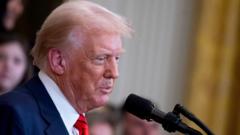In a significant move for sports policy and LGBTQ rights, President Donald Trump has enacted an executive order prohibiting transgender women from participating in women's sports categories. This directive seeks to amend regulations under Title IX, ultimately empowering the Department of Education to investigate schools that are perceived to be in breach of this new standard. Despite Republican claims that the order ensures fairness in athletics, numerous LGBT advocacy groups and human rights organizations have condemned the action as discriminatory and harmful.
Trump Issues Executive Order to Bar Transgender Women from Competing in Female Sports

Trump Issues Executive Order to Bar Transgender Women from Competing in Female Sports
President Trump's latest directive ignites debate over fairness in athletics versus discrimination against transgender rights.
The order takes immediate effect, primarily targeting high school, collegiate, and grassroots sports, and aligns with similar actions taken by various governing athletic bodies, such as those in swimming and athletics, explicitly preventing transgender women from competing against cisgender females if they have undergone male puberty. The White House has asserted that this executive action is an essential step to maintain equity in sports while aiming to purge what Trump characterized as the “war on women’s sports,” especially in anticipation of the upcoming 2028 Olympic Games in Los Angeles.
Trump’s order initiates a plan for the Department of Education to monitor compliance with Title IX and manipulate federal funding as a means of enforcement. Emphasizing the need for female athlete representation, he has invited bodies like the NCAA to engage in discussions regarding the implications of transgender athletes in women’s sports.
While the administration touts the policy as broadly popular among the American public, critics, including the Human Rights Campaign, argue that it generates an environment ripe for harassment and discrimination, reinforcing harmful stereotypes regarding gender identity. They highlight the negative impact of such legislation on young people seeking acceptance and support through sports—a sentiment echoed by research revealing that only a small fraction of the total US population identifies as transgender.
This action represents a sharp pivot from the previous Biden administration's stance on protecting LGBTQ rights within federally financed educational settings, raising questions on the balance between fair competition and inclusivity in sports.
As the conversation continues, stakeholders from various sectors, including sports, education, and advocacy, will be closely monitoring the implications of this new order and its potential effects on the future landscape of women’s sports and transgender rights in the United States.
Trump’s order initiates a plan for the Department of Education to monitor compliance with Title IX and manipulate federal funding as a means of enforcement. Emphasizing the need for female athlete representation, he has invited bodies like the NCAA to engage in discussions regarding the implications of transgender athletes in women’s sports.
While the administration touts the policy as broadly popular among the American public, critics, including the Human Rights Campaign, argue that it generates an environment ripe for harassment and discrimination, reinforcing harmful stereotypes regarding gender identity. They highlight the negative impact of such legislation on young people seeking acceptance and support through sports—a sentiment echoed by research revealing that only a small fraction of the total US population identifies as transgender.
This action represents a sharp pivot from the previous Biden administration's stance on protecting LGBTQ rights within federally financed educational settings, raising questions on the balance between fair competition and inclusivity in sports.
As the conversation continues, stakeholders from various sectors, including sports, education, and advocacy, will be closely monitoring the implications of this new order and its potential effects on the future landscape of women’s sports and transgender rights in the United States.




















